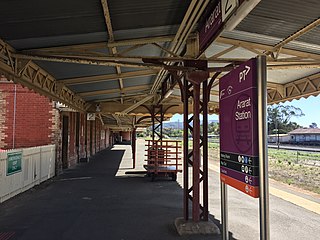
Broadmeadows railway station is located on the Craigieburn line in Victoria, Australia. It serves the northern Melbourne suburb of Broadmeadows, and opened on 1 February 1873.

Newport railway station is the junction for the Werribee and Williamstown lines in Victoria, Australia. It serves the western Melbourne suburb of Newport, and opened on 1 March 1859 as Geelong Junction. It was renamed Williamstown Junction in January 1869, and renamed Newport on 1 November 1881.

V/Line is a statutory authority that operates regional passenger train and coach services in Victoria, Australia. It provides passenger train services on five commuter lines and eight long-distance routes from its major hub at Southern Cross railway station in Melbourne. It also provides bus services across Victoria and into New South Wales, the Australian Capital Territory and South Australia. In addition, V/Line is responsible for the maintenance of much of the Victorian freight and passenger rail network outside of the areas managed by Metro Trains Melbourne and the Australian Rail Track Corporation.

Rail transport in the Australian state of Victoria is provided by a number of railway operators who operate over the government-owned railway lines. The network consists of 2,357 km of Victorian broad gauge lines, and 1,912 km of standard gauge freight and interstate lines; the latter increasing with gauge conversion of the former. Historically, a few experimental 762 mm gauge lines were built, along with various private logging, mining and industrial railways. The rail network radiates from the state capital, Melbourne, with main interstate links to Sydney and to Adelaide, as well as major lines running to regional centres, upgraded as part of the Regional Fast Rail project.
Kilmore East railway station is located on the North East line in Victoria, Australia. It serves the town of Kilmore East, and opened on 18 April 1872 as Kilmore. It was renamed Kilmore East on 1 October 1888.

Wangaratta railway station is located on the North East line in Victoria, Australia. It serves the town of Wangaratta, and it opened on 28 October 1873.

Chiltern railway station is located on the North East line in Victoria, Australia. It serves the town of Chiltern, and it opened on 21 November 1873.
The North East railway line is a railway line in Victoria, Australia. The line runs from Albury railway station in the border settlement of Albury–Wodonga to Southern Cross railway station on the western edge of the Melbourne central business district, serving the cities of Wangaratta and Seymour, and smaller towns in northeastern Victoria. The line is owned by VicTrack, but leased to, and maintained by, the Australian Rail Track Corporation, and forms part of the Sydney–Melbourne rail corridor.

Ararat railway station is located on the Serviceton and Western standard gauge lines in Victoria, Australia. It serves the town of Ararat, and opened on 7 April 1875.

Albury railway station is a heritage-listed railway station at Railway Place, Albury, New South Wales, Australia, adjacent to the border with Victoria, in Australia. It was designed under the direction of John Whitton and built from 1880 to 1881. It was added to the New South Wales State Heritage Register in 1999.

The N Class are a class of diesel locomotives built by Clyde Engineering, Somerton for V/Line between 1985 and 1987.

VicTrack, the trading name of Victorian Rail Track Corporation, is a Victorian Government state-owned enterprise which owns all railway and tram lines, associated rail lands and other rail-related infrastructure in the state of Victoria, Australia, with the exception of the Emerald Tourist Railway Board's heritage Puffing Billy Railway.

The rail network of Melbourne, Australia, has a significant number of railway lines and yards serving freight traffic. Rail transport in Victoria is heavily focused on Melbourne, and, as a consequence, much of the state's rail freight passes through the metropolitan network.
The Western standard gauge railway line is a standard-gauge railway line in western Victoria, Australia. Completed in 1995, it forms part of the Melbourne–Adelaide rail corridor and serves as the principal interstate rail link between Victoria and the western states. The line replaced a number of former broad gauge routes which were gauge converted, and today sees both intrastate and interstate freight traffic, as well as the twice weekly The Overland passenger service. Major towns on the route include Geelong, Ararat, Horsham and Dimboola.
The Sydney–Melbourne rail corridor is an approximately 953-kilometre (592 mi) standard gauge railway corridor that runs between Melbourne (Victoria) and Sydney, the two largest cities in Australia. Freight and passenger services operate along the route, such as the NSW TrainLink XPT passenger service. The XPT offers a day and night service in each direction.

The Albury line is a regional passenger rail service operated by V/Line in Victoria, Australia. It serves passengers between state capital Melbourne and the regional cities of Benalla, Wangaratta, Wodonga, and the NSW border city of Albury.
The Geelong–Ballarat railway line is a broad-gauge railway in western Victoria, Australia between the cities of Geelong and Ballarat. Towns on the route include Bannockburn, Lethbridge, Meredith, Elaine and Lal Lal. Major traffic includes general freight from the Mildura line, and grain.

The Cudgewa railway line is a closed railway line in the north-east of Victoria, Australia. Branching off the main North East line at Wodonga it ran east to a final terminus at Cudgewa. The High Country Rail Trail now uses most of the railway reserve.

Roxburgh Park railway station is located on the Craigieburn line in Victoria, Australia. It serves the northern Melbourne suburb of Roxburgh Park, and opened on 21 September 2007.















